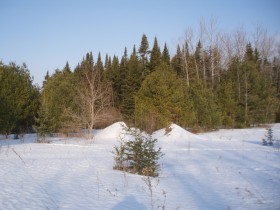Trails: Groomed Sunday afternoon. Conditions excellent.
During the first visit from the Polar Vortex, the sound of a gunshot rang out from the forest at Crossroads. Except it wasn’t a gun. It was a tree splitting. I fear our January weather may have been hard on some trees.
Anyone who has ever made the mistake of leaving a pop bottle in a freezer knows that when water freezes, it expands, shattering the bottle. Something similar happens with trees. Even though it may seem that trees are solid, the living parts are mostly water–about 90% water, and if that water freezes, the tree bark can split. Stressed and previously injured trees are most vulnerable, and the splitting occurs most often on the south or southwest-facing side which is warmed by even the winter sun. Most healthy native trees do not develop these huge cracks because they have prepared for winter cold through a process called “hardening.”
Last fall, when it began getting chilly and daylight decreased, many changes took place in trees. Leaves dropped and most of the trees’ food migrated into the roots. But changes occurred at the cellular level as well.
If water in plant cells freezes, sharp needlelike crystals form, and these crystals can puncture the cell walls. Not good. So in fall, water moves out of the tree cells into the space between the cells.. The water these spaces freezes, but little harm is done to the tree. Besides that, when the water moves into the spaces, the chemicals that are left in the cells act as an antifreeze.
When temperatures decrease gradually, hardening occurs. But, if it gets warm, a tree can de-harden. And that only takes a couple days. [It’s sort of like dieting. Months of mindful eating can be undone by a few days of holiday feasting.] For trees, the worst situation occurs when three or four days of warm weather are followed by a sudden drop in temperature. Cell damage and even splitting can result.
And after the cold this month, if you remember, to add injury to injury, we had an ice storm. Researcher tell us a layer of ice can increase the weight of branches by 30 times. And then, our ice storm was followed by heavy snow.
So the question, during this crazy month is [and we don’t know yet] was the ice thick enough to cause damage and was the mild spell which followed the extreme cold long enough to de-harden the trees? Probably not. Our native trees are adapted to temperature fluctuation and have survived the Wisconsin climate for millennia. Some of our non-native ornamentals….well, we will see.


